Have you ever felt overwhelmed by clutter and longed for a space that feels calm and effortlessly organized? Minimalist secrets for a tidy home have gained immense popularity because they promise simplicity, peace, and a sense of control amidst today’s busy lives. In this article, you’ll uncover a variety of practical and stylish ideas to create a more minimalist, clutter-free environment. From clever storage solutions to design tips, these secrets will inspire you to transform your space into a serene sanctuary that reflects simple living at its best.
1. Embrace Neutral Color Palettes for Calm, Clutter-Free Spaces
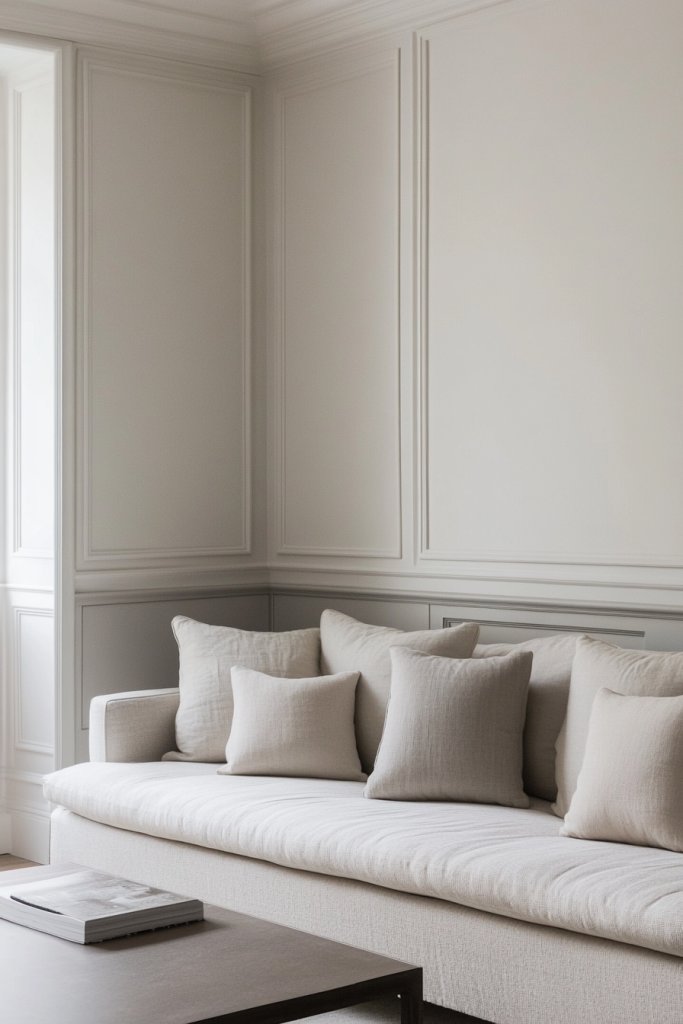
Ever walk into a room that feels chaotic even though it’s not messy? Sometimes, the secret to a peaceful space is simply choosing the right colors. Neutral palettes like whites, beiges, and soft grays create an environment that naturally calms the mind.
They help your space look bigger and more organized instantly. Who wouldn’t want a home that feels peaceful just by changing a few paints? Imagine walls painted in warm cream tones that reflect soft sunlight, making the room glow gently.
The furniture blends seamlessly in muted shades, while textured textiles add depth without overwhelming. Light-colored rugs and curtains keep the space airy, and minimal accessories stand out more because of the subdued backdrop.
It’s a calming, cohesive visual that invites you to relax, not stress. Neutral colors adapt well to any season—think crisp whites in summer and cozy beiges in winter.
You can layer different shades of the same tone for subtle variation or add pops of color through small accessories like pillows or throws. For smaller rooms, keep the palette monochrome to maximize openness, while larger spaces can handle layered neutrals for depth.
It’s all about creating harmony within your space. Start by selecting neutral shades that suit your lighting and mood preferences.
Use matte or satin finishes to avoid glare and keep surfaces subtle. When painting, opt for high-quality, low-VOC paints for a healthier home environment.
Keep your décor minimal—furniture with clean lines and simple textiles work best. Avoid cluttered surfaces by integrating hidden storage options and organizing essentials efficiently.
Introduce textures to add interest—think a soft, cream throw blanket with chunky knit texture or a woven basket in a neutral tone. Incorporate natural materials like wood or stone to add warmth.
Personalize through subtle patterns in textiles or small decorative items that don’t overpower the palette. The goal is a space that feels cohesive but still reflects your personality.
Neutral palettes are timeless and versatile, making your home feel calm yet stylish. They serve as a perfect backdrop for any seasonal decor or personal updates.
Plus, they tend to age gracefully, so your space stays fresh with minimal effort. Ready to embrace calm, clean, and clutter-free living? Your peaceful home awaits.
2. Incorporate Hidden Storage Solutions for a Seamless Look
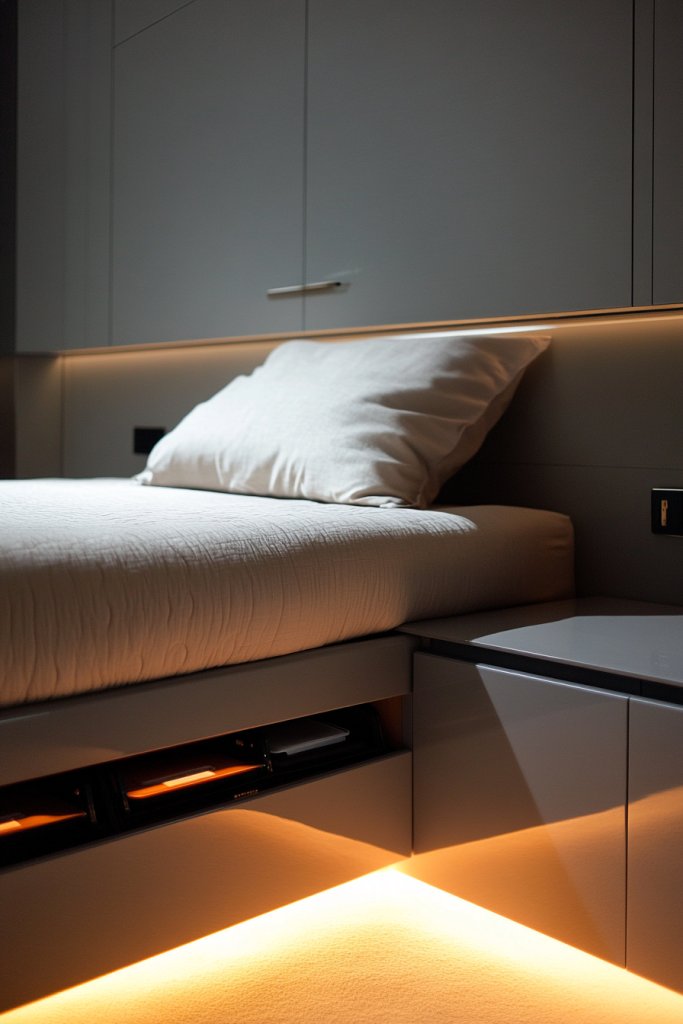
Clutter is the enemy of a tidy home, but who wants to live in a storage closet? The trick is hiding that chaos away without sacrificing style. Hidden storage solutions give you space to stash essentials out of sight, keeping surfaces clean and rooms feeling spacious.
Recommended Products to replicate this idea
| # | Preview | Product | |
|---|---|---|---|
| 1 |

|
Huatean Home 48" Ottoman with Storage, Storage Ottoman Bench with Safety Hinge, Upholstered Entryway... | Check Latest Price |
| # | Preview | Product | |
|---|---|---|---|
| 1 |

|
Lifezone Queen Bed Frame with 2-Tier Storage Headboard, Metal Platform Bed Frame with 4 Storage... | Check Latest Price |
It’s like having a magic stash that keeps everything you need but nobody can see. Picture a sleek coffee table with drawers that hide remotes and magazines or a bed frame with built-in compartments for extra blankets and shoes.
Underneath-bed storage drawers slide smoothly out, while ottomans with removable tops serve as both seating and hidden bins. These features maintain a streamlined aesthetic, making your space feel uncluttered and inviting.
The secret is that the storage isn’t bulky—it’s integrated. Choose furniture with built-in storage to suit your space—think wall-mounted cabinets for small rooms or multi-purpose beds in studio apartments.
Opt for minimalist, handle-less drawers or soft-close mechanisms to keep the look clean. You can also incorporate hidden baskets or fabric bins inside open shelving for a flexible, less permanent solution.
Seasonal storage can be tucked away behind decorative panels or behind furniture. Start by assessing your storage needs and available space.
Invest in furniture with integrated compartments or retrofit existing pieces with removable bins. Use labels for bins to find items quickly without digging through everything.
For DIY projects, install shallow wall-mounted cabinets or use hollowed-out furniture pieces. Remember to keep frequently used items accessible and less-used items tucked away.
Regular tidying prevents clutter from sneaking back. Customize storage with decorative fabric linings or labels that reflect your style.
Use matching materials like wood or neutral-toned plastics to keep the look cohesive. Add a few decorative trays or boxes inside cabinets to organize smaller items.
You can even incorporate hidden compartments within existing furniture for a personalized touch. This approach makes storage feel intentional and aesthetic.
Hidden storage solutions transform chaos into calm without sacrificing style. They make daily routines easier and your home more enjoyable.
Over time, they become second nature—just open a drawer or lift a cushion to access what you need. Ready to hide the clutter and enjoy a seamless look? Your tidy home is within reach.
3. Opt for Multi-Functional Furniture to Maximize Space
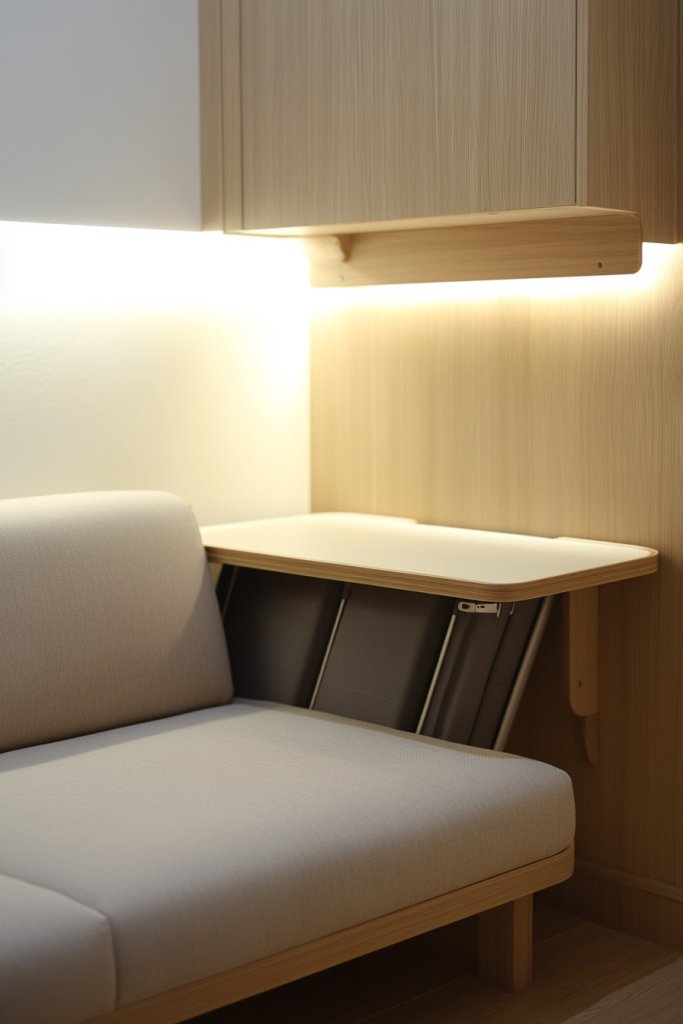
Ever wish your furniture could do more than just sit there? Multi-functional pieces are the perfect solution for small or busy homes. They help you save space while adding versatility and style.
Recommended Products to replicate this idea
| # | Preview | Product | |
|---|---|---|---|
| 1 |

|
LUXOAK Murphy Bed with Charging Station, Queen Size Cabinet Bed with Large Storage Drawer for Home... | Check Latest Price |
| # | Preview | Product | |
|---|---|---|---|
| 1 |

|
41 in-78 in Extendable Dining Room Table for 4-8, Round Expandable Kitchen Table with Fluted Base,... | Check Latest Price |
Why settle for one purpose when one piece can serve multiple needs? It’s like getting more bang for your buck—and space. Imagine a sleek sofa that folds out into a bed for guests or a fold-away desk hidden behind a panel that swings out when needed.
A dining table that extends to accommodate friends or a storage ottoman that doubles as a coffee table. These pieces blend seamlessly into your decor, maintaining a minimalist look while offering maximum utility.
They’re the ultimate space-savers. Choose furniture that aligns with your lifestyle—sleek, modern designs for a contemporary look, or rustic, chunky pieces for a cozy vibe.
Adjust the functionality to your needs: a desk that folds into a wall, a bed with integrated drawers, or a sofa with built-in storage. Adapt these solutions seasonally by swapping out covers or accessories.
The key is flexibility. Start by identifying your space’s biggest challenges.
Research multi-purpose furniture that matches your style and fits your measurements. Prioritize quality construction to ensure durability, especially for fold-out or convertible pieces.
Consider DIY options like adding a fold-down table or creating a Murphy desk. Measure carefully and plan your layout to prevent overcrowding.
Add personality by customizing your furniture—think painted finishes, personalized handles, or decorative cushions. Incorporate contrasting textures or colors to highlight certain pieces or to create visual interest.
Use accessories like decorative trays or storage baskets to keep items organized within the multi-functional pieces. This makes your furniture not just practical but also stylish.
Multi-functional furniture turns small spaces into highly functional areas without sacrificing style. It keeps your home feeling open and adaptable, perfect for evolving needs.
With the right pieces, you can host guests comfortably or enjoy a clutter-free environment. Ready to maximize your space with clever, versatile furniture? Let’s do it!
4. Use Minimalist Wall-Mounted Shelves for Organized Display
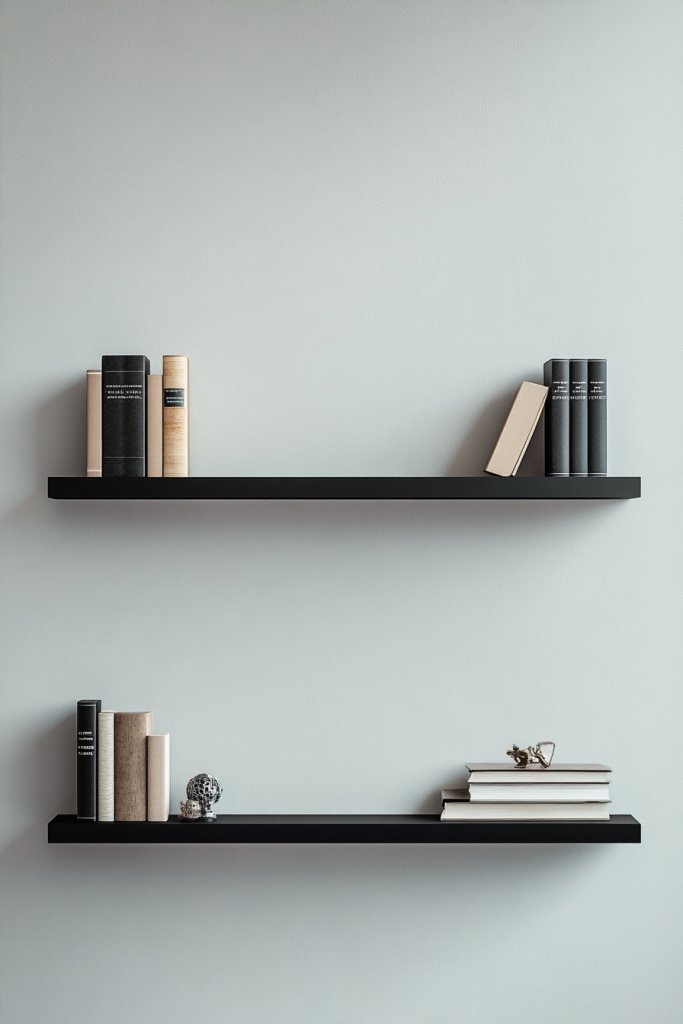
Surface clutter feels unavoidable sometimes, especially when you want to display your favorite books or decor. Wall-mounted shelves offer a sleek solution, keeping your surfaces clean while adding visual interest.
Recommended Products to replicate this idea
| # | Preview | Product | |
|---|---|---|---|
| 1 |

|
BAYKA Floating Shelves for Wall, Wall Mounted Rustic Wood Shelves for Bathroom, Bedroom, Living... | Check Latest Price |
| # | Preview | Product | |
|---|---|---|---|
| 1 |

|
Ougourim Furniture Anchors (10 Packs) Anti Tip Furniture Anchors for Baby Proofing, Furniture Wall... | Check Latest Price |
They give you a place for your essentials without overcrowding your space. Who says storage can’t be stylish? Picture floating shelves in a soft matte finish, holding a curated collection of books, candles, or ceramics.
The clean lines draw the eye upward, making the room feel taller and more open. Minimalist brackets or hidden mounting systems keep the look seamless.
These shelves create a gallery-like effect, emphasizing quality over quantity. Install shelves at different heights for visual dynamism, or keep them aligned for a more uniform look.
Use narrow shelves in tight spaces or wider ones to display larger items. For a seasonal touch, swap out decorative objects or switch up the arrangement.
You can also incorporate corner shelves to maximize unused space. Choose durable, lightweight materials like MDF, wood, or metal for your shelves.
Measure carefully to ensure proper spacing and height. Use a level and appropriate anchors for secure mounting, especially in drywall.
Keep the clutter to a minimum—curate only a few meaningful or aesthetically pleasing objects per shelf. Regularly dust and organize your display to keep it looking fresh.
Paint shelves in a color that complements or contrasts with your wall for a bold statement. Add small decorative objects like sculptural pieces or framed quotes (avoiding artwork if restricted).
Incorporate textured items like woven baskets or fabric-covered boxes for variation. Personal touches elevate the minimalist look and make the display uniquely yours.
Wall-mounted shelves free up space and create a stylish focal point. They allow you to showcase your personality without cluttering surfaces.
Over time, a well-curated shelf becomes a source of inspiration and pride. Ready to elevate your organization game with sleek, floating shelves? Let’s hang them up!
5. Adopt a ‘One-In, One-Out’ Decluttering Habit
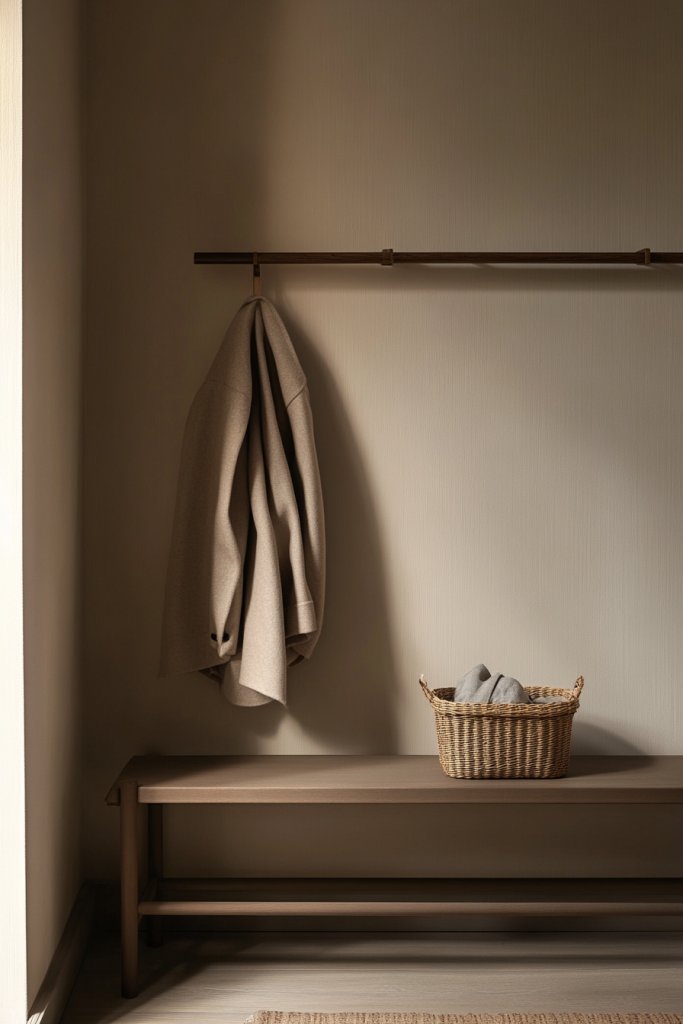
Clutter sneaks in when you’re not paying attention, turning tidy spaces into chaos. The ‘one-in, one-out’ rule is a simple but powerful habit to keep your home under control.
Recommended Products to replicate this idea
| # | Preview | Product | |
|---|---|---|---|
| 1 |

|
Sterilite 6-Pack Industrial Tote, Plastic Storage Container Bins with Lids, 27 Gallon - Heavy-Duty... | Check Latest Price |
| # | Preview | Product | |
|---|---|---|---|
| 1 |

|
SentrySafe Black Fireproof and Waterproof Safe, File Folder and Document Box with Key Lock, Ex. 14.3... | Check Latest Price |
Every time you bring something new in, you remove something old. It’s a way to maintain balance without constant overhauls.
Imagine a neatly organized closet where each new shirt is paired with an old one that’s donated or tossed. On your desk, old papers are cleared out as new ones arrive, thanks to a dedicated file or tray.
This habit creates a constantly refreshed space where everything has a place, and nothing feels overwhelming. Consistency is key.
Apply this rule to different areas—clothing, kitchen supplies, books—whatever tends to accumulate. For minimal clutter, combine it with regular scheduled decluttering sessions.
Use labeled bins or designated spaces to streamline the process. Seasonal or annual resets can deepen the effect, keeping your space fresh without much effort.
Start by choosing a specific area—like your wardrobe or pantry. Every time you add an item, evaluate whether you still need or love it.
Commit to removing an equivalent number of items from the same space. Keep a box or bag ready for donations or recycling.
Make it a daily or weekly habit, and set reminders if needed. Over time, it becomes second nature.
Create visual cues—like a small sign or a sticker—to remind yourself of this habit. Celebrate your progress with small rewards when you successfully declutter.
Incorporate a donate box that’s accessible and visible, encouraging ongoing participation. Personalize your system to fit your lifestyle for sustainable results.
This habit not only keeps your home tidy but also frees mental space, reducing stress. It cultivates mindfulness about consumption and storage.
As clutter diminishes, your space feels calmer and more inviting. Ready to master the art of mindful decluttering? Start today!
6. Select Simple, Streamlined Storage Bockets for Everyday Items
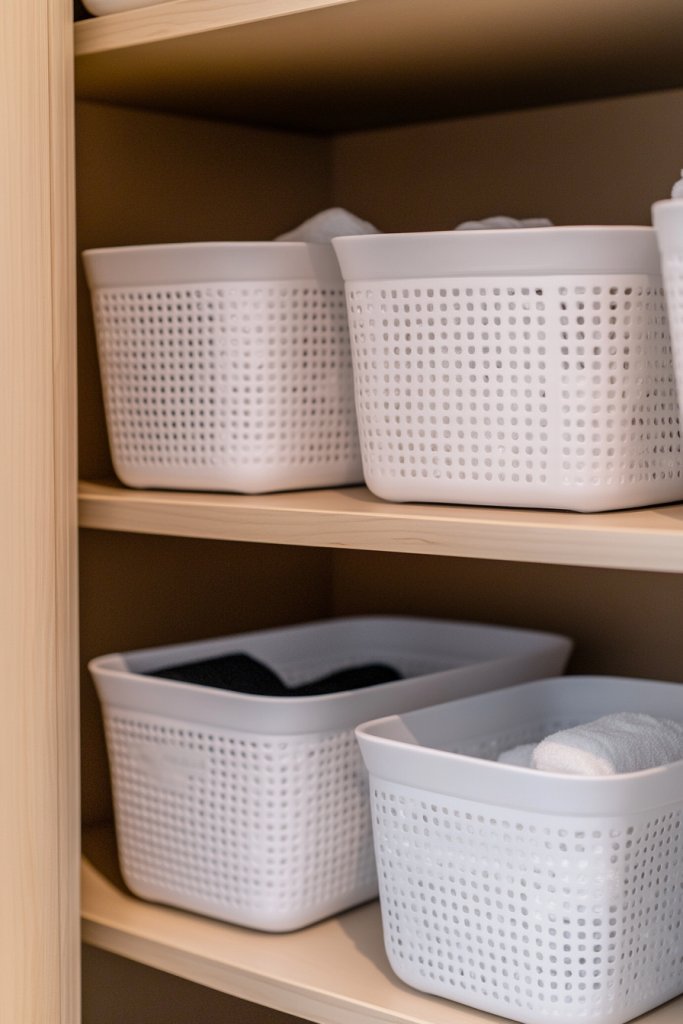
Messy drawers and cluttered shelves can make even the simplest daily routines stressful. The secret is choosing uniform, simple storage baskets or boxes that keep everything neat and accessible.
Consistent containers reduce visual chaos and make tidying up a breeze. Who knew organization could be so minimalist? Visualize a row of matching baskets in neutral tones on open shelves, each labeled for different items—chargers, accessories, cleaning supplies.
The uniformity creates a clean, cohesive look, and the contents are easy to find. This approach eliminates the ‘miscellaneous’ pile and transforms chaos into order.
It’s like having a tidy store in your own home. Use baskets or boxes in various sizes to accommodate different items, from small toiletries to larger household tools.
Opt for materials like woven wicker, fabric-lined cardboard, or sleek plastic for different aesthetics. Incorporate clear lids or open designs based on accessibility needs.
Match or contrast with your decor for a unified look. Start by sorting items into categories—use labels for quick identification.
Choose baskets that fit your space and storage needs, avoiding overly decorative units that may look cluttered. Stack or line up containers for maximum efficiency.
Regularly review and re-organize to prevent buildup. Keep essentials within easy reach and less-frequent items tucked away.
Add decorative touches like fabric liners or personalized labels to make storage more appealing. Incorporate a color scheme that complements your room’s palette.
Use uniform containers for a polished look or mix textures for visual interest. Personal touches motivate ongoing organization.
Consistent use of simple storage baskets streamlines your daily routine and keeps your home feeling calm. Over time, it becomes second nature to put things back in their designated containers.
Your space will look more intentional and peaceful. Ready to organize with style? Start with matching baskets today!
7. Maintain Clear Countertops with Concealed Appliance Storage
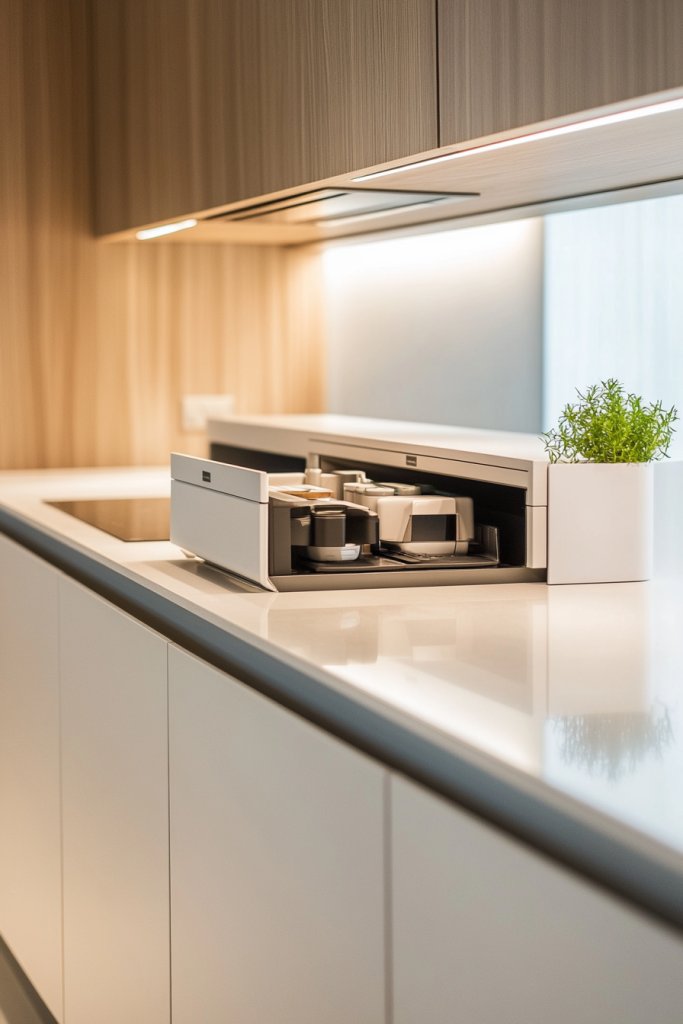
Countertops cluttered with small appliances can make your kitchen look chaotic, even if everything is clean. The trick is to store appliances out of sight when not in use, preserving a sleek, minimalist surface.
Recommended Products to replicate this idea
| # | Preview | Product | |
|---|---|---|---|
| 1 |

|
Omega National Appliance Garage Hickory 24"W x 18.5"H | Check Latest Price |
| # | Preview | Product | |
|---|---|---|---|
| 1 |

|
Vtopmart 25 PCS Clear Plastic Drawer Organizers Set, 4-Size Versatile Bathroom and Vanity Drawer... | Check Latest Price |
Clear counters help your space feel larger, calmer, and more inviting. Who doesn’t want that? Picture a pristine kitchen with a smooth, uninterrupted countertop—no toaster, blender, or coffee maker in sight.
Instead, these appliances are tucked into custom cabinets or built-in drawers, with only the cords and minimal accessories visible. The space feels open and orderly, making meal prep more enjoyable.
It’s a clean canvas ready for creativity. Choose appliances with hidden storage options or dedicate a specific cabinet for small gadgets.
Use appliance garages or countertop covers that hide devices when not in use. Seasonal or occasional-use appliances can be stored in higher cabinets or under counters.
Incorporate stylish cord management to keep things tidy. Start by decluttering and evaluating which appliances are used daily.
Invest in attractive storage solutions, like pull-out drawers or appliance garages, designed to blend with your cabinetry. Use cord clips and sleeves to hide wires, preventing tangles and visual clutter.
Keep only essential items on the countertop; store the rest behind cabinet doors or in drawers. Regularly reassess to avoid accumulation.
Personalize storage spaces with labels or decorative hardware. Opt for matching containers or covers to create a cohesive look.
Use sleek, minimalistic appliance designs that complement your decor. Consider adding a small tray or organizer for frequently used gadgets to keep them accessible yet hidden.
A clutter-free countertop elevates your entire kitchen aesthetic and simplifies daily routines. It reduces stress and makes cleaning easier.
Once you master concealed storage, your space looks more polished and intentional. Ready to enjoy a sleek, organized kitchen? Let’s hide those appliances!
8. Use Monochrome or Limited Color Accents for Visual Cohesion
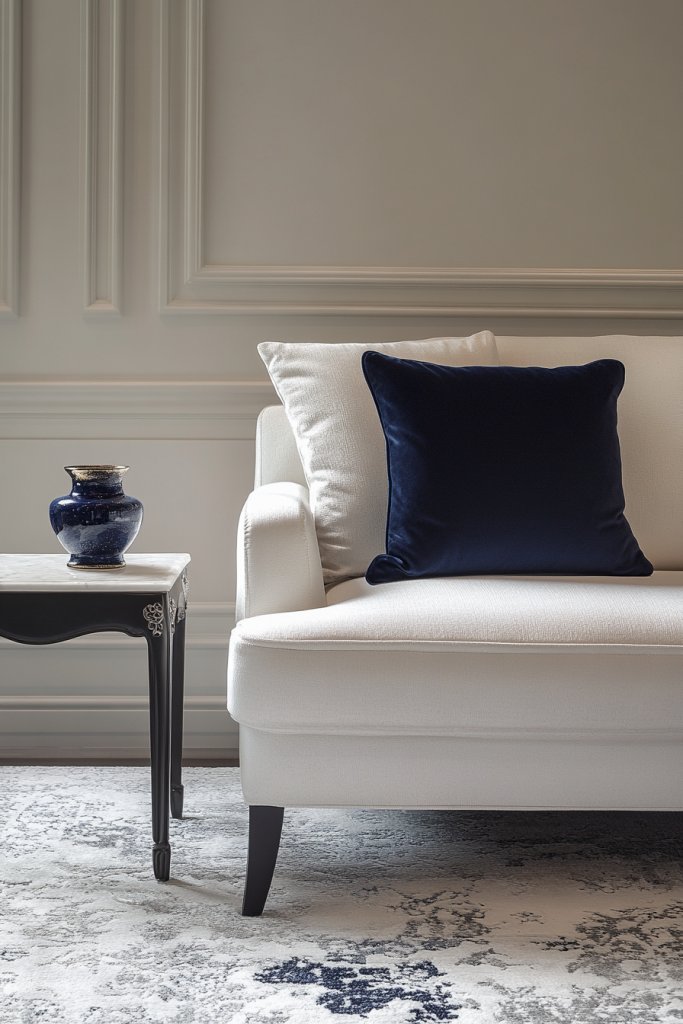
Clashing colors and overly busy decor can make a home feel chaotic instead of calming. The solution? Stick to a monochrome palette or add limited, intentional accents.
Recommended Products to replicate this idea
| # | Preview | Product | |
|---|---|---|---|
| 1 |

|
Ophanie Area Rugs for Living Room Bedroom, Upgrade Non-Slip Fluffy Soft Grey Shag Carpet, Indoor... | Check Latest Price |
| # | Preview | Product | |
|---|---|---|---|
| 1 |

|
Utopia Bedding Throw Pillows (Set of 4, White), 20 x 20 Inches Pillows for Sofa, Bed and Couch... | Check Latest Price |
This approach creates harmony and visual flow, making your space look more curated and peaceful. Who knew restraint could look so stylish? Imagine a living room where shades of grey and beige dominate, with a few select accessories in muted blush or navy.
Textures like plush throws or matte ceramics add depth without breaking the harmony. The overall effect is sophisticated yet cozy, with every element working together seamlessly.
It’s a visual symphony of calm. Use monochrome tones for larger furniture and wall colors, then add subtle accents in a single complementary hue.
For a more dynamic look, choose a primary neutral with a splash of color in cushions, throws, or small decor items. Seasonal updates can be as simple as swapping out accessories in the same color family.
Keep the palette simple for maximum impact. Select a base color that suits your space and lighting.
Use paint, textiles, and major furniture pieces in shades of that color. Incorporate small accents—like pillows or storage boxes—in one or two complementary hues.
Avoid over-accessorizing; less is more. Balance the color distribution to prevent the space from feeling dull or overwhelming.
Add texture with varied fabrics, matte versus glossy finishes, or woven materials that stay within your color scheme. Personalize with unique objects that match your limited palette but still reflect your personality.
Carefully curated collections of items in matching tones elevate the overall aesthetic. It’s about harmony and subtlety.
Using a limited color scheme simplifies decorating and makes future updates easy. It also creates a calm, cohesive environment that feels intentional.
Your space will look effortlessly stylish, and you’ll feel more relaxed every time you enter. Want a home that exudes calm and sophistication? Start with a limited palette.
9. Implement Clutter-Free Entryways with Slim Storage Racks
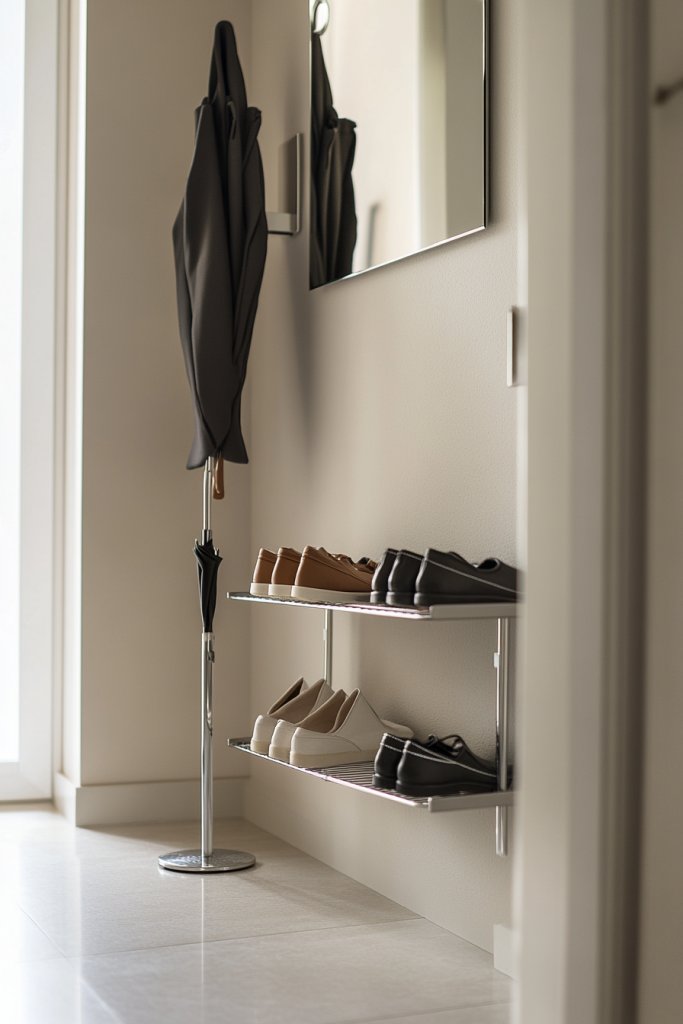
Entryways often become dumping grounds for everything—shoes, bags, umbrellas—which quickly turn chaotic. A clutter-free entryway sets the tone for a tidy home and makes daily routines smoother.
Slim storage racks are the perfect way to organize without sacrificing space or style. Who wants to start their day in chaos? Visualize a narrow wall-mounted rack with sleek hooks and a slim shelf above for keys and sunglasses.
Shoes are stored neatly in a compact shoe rack or cubbies underneath. The space remains open, inviting, and functional.
Minimalist design ensures the entryway feels calm and welcoming rather than cluttered. Choose wall-mounted hooks for coats and bags or slim bench seats with hidden compartments underneath.
Use vertical space with tall, narrow racks or install multiple hooks at different heights for versatility. Seasonal accessories like umbrellas or hats can be stored in nearby bins or baskets for easy access.
Adjust the storage based on your space and needs. Start by decluttering your current entry area.
Measure available wall space to select appropriately sized racks or hooks. Install using proper anchors to ensure safety and stability.
Keep the design simple—metal or wood in neutral finishes work well—and avoid overloading hooks. Regularly tidy and reassess to prevent buildup.
Add labels or small decorative touches like woven baskets or fabric-lined boxes to hide away smaller items. Choose hardware that matches your decor style—sleek metal or matte black for modern, warm wood for rustic.
Personalize with a small mirror or a decorative tray for keys to make it functional and attractive. The goal is a tidy, personalized entry.
An organized entryway boosts your mood and keeps your home tidy from the moment you step inside. It’s a small change that makes a big difference in daily life.
With a little effort, your home greets you with calm and order every day. Ready to transform your entry? Let’s organize!
10. Choose Simple, Unadorned Window Treatments for a Cohesive Look
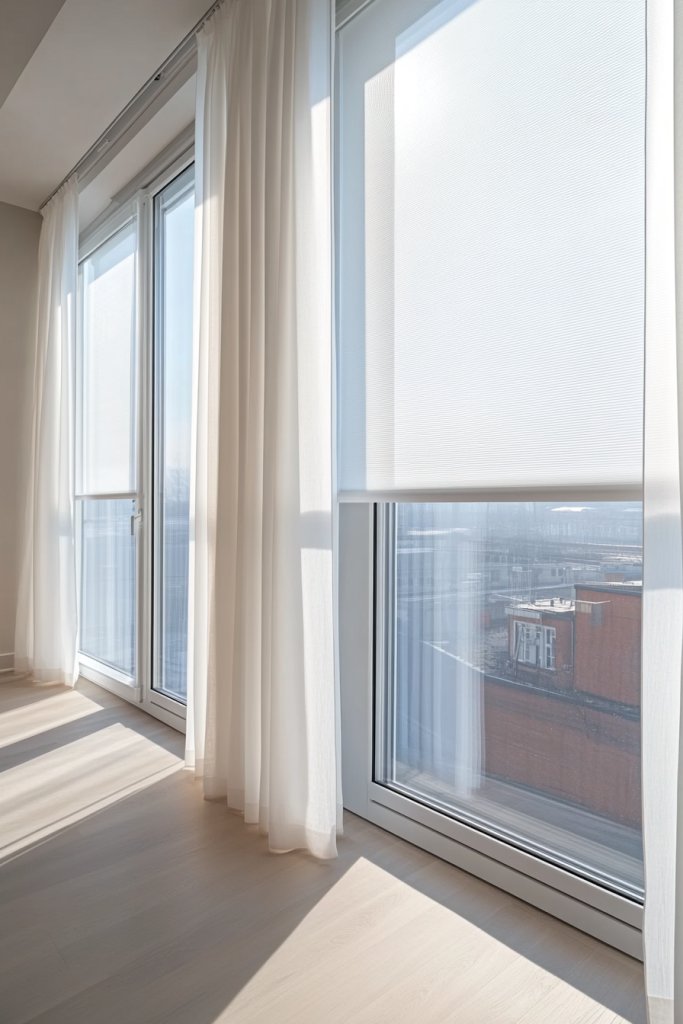
Heavy drapes and ornate blinds can clutter up a room visually, distracting from your overall design. Simple, unadorned window treatments create a clean, cohesive aesthetic that complements minimalist decor.
Recommended Products to replicate this idea
| # | Preview | Product | |
|---|---|---|---|
| 1 |

|
AOSKY Blackout Roller Shades Cordless Blinds for Windows, Free-Stop Shades with Valance, Thermal... | Check Latest Price |
| # | Preview | Product | |
|---|---|---|---|
| 1 |

|
Cordless Light Filtering Mini Blinds for Indoor Windows - 34 Inch Width, 64 Inch Length, 1" Slat... | Check Latest Price |
They also allow natural light to flood your space, making it feel brighter and more open. Who doesn’t want that? Picture sleek roller shades in a neutral tone, fitting seamlessly into the window frame.
They roll up completely during the day, revealing the view and flooding the room with sunlight. When lowered, they provide privacy without adding visual clutter.
The streamlined look makes your windows a subtle, stylish feature rather than a focal point. Opt for materials like linen, cotton, or blackout fabrics in simple colors.
Choose roller shades, sleek blinds, or panel track systems for a modern look. For a softer feel, add a thin decorative trim or a subtle pattern—keeping it minimal.
Seasonal updates can be as simple as changing fabric colors or textures. Measure your windows accurately to select the right size.
Install brackets securely using proper anchors, ensuring smooth operation. Opt for cordless or motorized options for a clean look and ease of use.
Keep the hardware in neutral finishes that blend with your walls. Regularly clean and maintain for a fresh appearance.
Coordinate window treatments with your overall color palette for harmony. Use simple decorative rods or minimal hardware to maintain the streamlined aesthetic.
If desired, layer with light-filtering panels or sheer curtains for added softness without clutter. Personal touches like subtle patterns or textures personalize the space.
Simple window treatments elevate your entire room’s look, making it feel more cohesive and spacious. They’re a subtle upgrade that adds polish without complexity.
Once installed, they become an effortless part of your daily routine. Want a sleek, tidy home? Start with your windows.
11. Incorporate Open Space with Minimal Decor on Surfaces
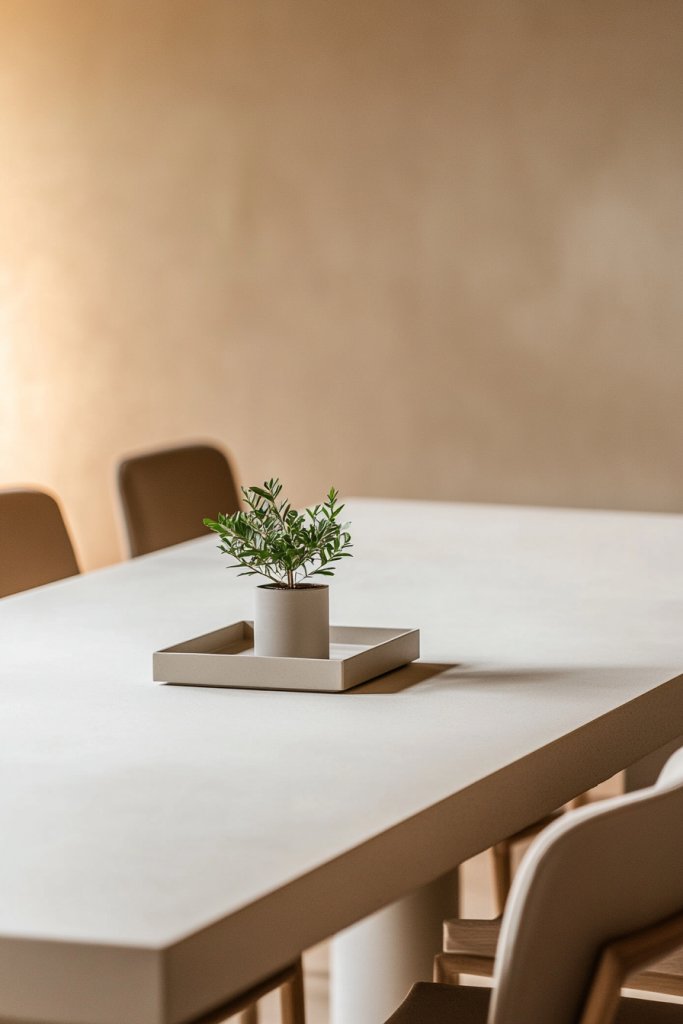
Surfaces covered in knick-knacks, candles, and clutter make a space feel busy rather than peaceful. Embracing open space with minimal decor creates a calming environment that invites relaxation.
Recommended Products to replicate this idea
| # | Preview | Product | |
|---|---|---|---|
| 1 |

|
DOWAN 22 OZ White Ceramic Bowls Set of 4 - Perfect for Soup Bowls for Kitchen, Cereal Bowl, Ramen... | Check Latest Price |
| # | Preview | Product | |
|---|---|---|---|
| 1 |

|
WELLAND Irregular Cedar Wood Sculpture 8.75" W x 1.75" D x 17.75" H Natural Edge Tabletop Statues,... | Check Latest Price |
It’s about choosing quality over quantity and letting your space breathe. Who doesn’t crave a home that feels uncluttered? Visualize a dining table with only a single statement bowl or a coffee table with one sculptural piece and a textured tray.
The effect is a balanced, uncluttered look that emphasizes the beauty of each item. Clear surfaces also reflect light better, enhancing the sense of openness.
Less truly is more. Limit decorative objects to a few meaningful pieces—think a beautifully crafted ceramic or a unique sculpture.
Rotate decor seasonally or periodically to keep the space fresh. For small surfaces, use trays or shallow bowls to contain essentials and reduce visual clutter.
Keep counters and tables free of non-essential items. Identify surfaces that tend to gather clutter.
Clear everything and only add items that hold personal or aesthetic value. Use trays or small containers to organize items like keys or remotes.
Regularly review and remove unnecessary objects. Incorporate textured textiles or natural materials for visual interest without overcrowding.
Select decor in neutral tones or natural textures that blend with your overall aesthetic. Incorporate meaningful objects like handmade ceramics or heirlooms to add character.
Use a consistent style or color scheme to unify the look. Personal touches make minimal decor feel intentional and curated.
A clutter-free surface instantly makes your home feel more spacious and inviting. It also reduces stress and mental clutter, making daily routines smoother.
Over time, your home will reflect your refined taste and minimalist mindset. Want a serene, tidy space? Start with your surfaces today.
12. Use Vertical Space for Storage and Display
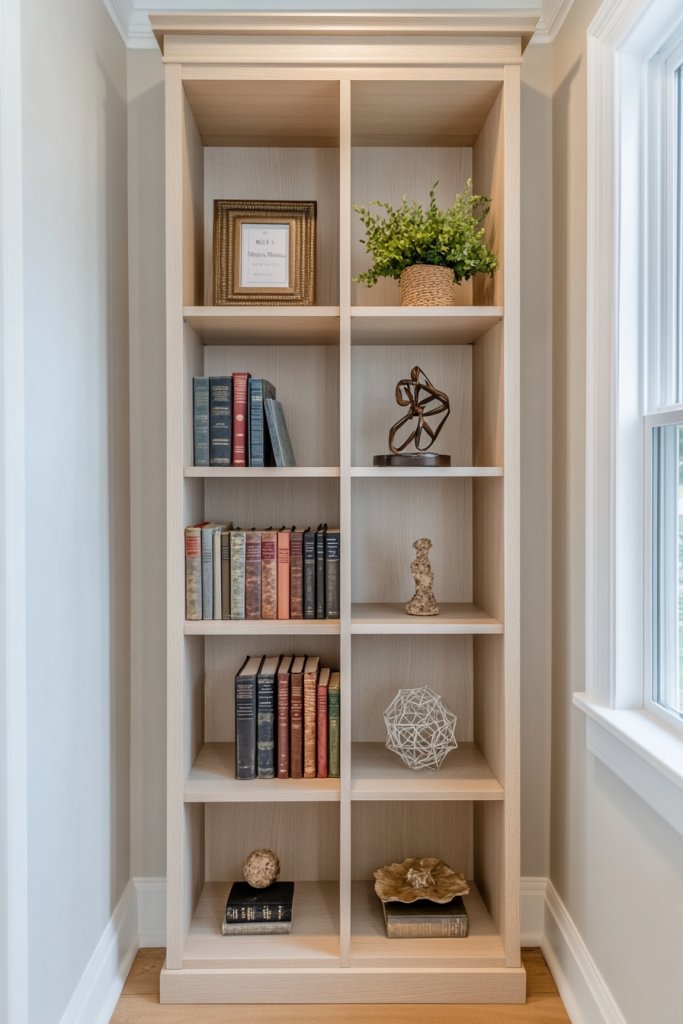
Floor space can quickly feel cramped and cluttered, especially in smaller homes. Using vertical space is an easy way to add storage and display options without sacrificing precious floor area.
Recommended Products to replicate this idea
| # | Preview | Product | |
|---|---|---|---|
| 1 |

|
ROMGUAR CRAFT Corner Floating Shelves Wall Mounted Set of 4, Rustic Wood Storage Display Wall... | Check Latest Price |
| # | Preview | Product | |
|---|---|---|---|
| 1 |

|
Govee RGBIC LED Strip Lights, Smart LED Lights for Bedroom, Bluetooth LED Lights APP Control, DIY... | Check Latest Price |
It’s a smart move that instantly makes a room feel larger and more organized. Who doesn’t want more room to breathe? Imagine tall, slim shelves reaching up to the ceiling, filled with neatly arranged boxes, folded textiles, or decorative objects.
Hanging hooks or pegboards can hold tools, accessories, or kitchen utensils, keeping everything within easy reach but out of sight. The vertical lines create a sense of height, making the room feel more expansive.
Incorporate tall shelving units or wall-mounted organizers in your favorite room. Use floating shelves or hanging baskets for a minimalist look.
For small spaces, vertical storage can be combined with hidden compartments or foldaway units. Adjust the height and number of shelves based on your ceiling height and needs.
Measure wall spaces carefully before installing shelves or organizers. Use sturdy anchors and brackets for safety, especially in high-traffic areas.
Select materials that match your decor—wood, metal, or composite. Organize items by frequency of use for quick access, and avoid overcrowding shelves for a clean look.
Regularly reassess your storage needs. Paint or stain shelves in a color that complements your walls for a seamless look.
Add small decorative elements like baskets or boxes that match your aesthetic. Personalize with labels or tags for easy identification.
Use lighting, like LED strips, to highlight displays and create ambiance. Vertical storage utilizes otherwise wasted space and creates a dynamic, layered look.
It makes your home more functional and visually interesting without cluttering the floor. Over time, it helps you develop a more organized mindset. Ready to reach new heights in home organization? Let’s go vertical!
13. Select Uniform, Low-Profile Furniture for a Cohesive Flow
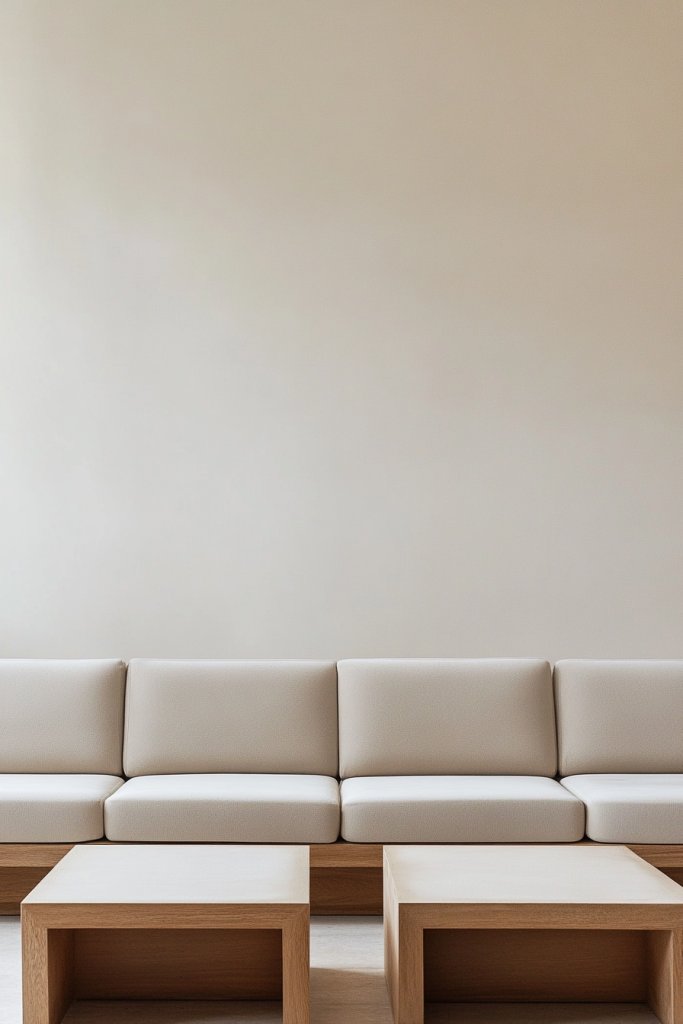
Furniture with inconsistent styles or heights can disrupt the flow of a room, making it feel disjointed. Choosing uniform, low-profile pieces creates a harmonious environment that’s visually calming and easy to navigate.
Recommended Products to replicate this idea
| # | Preview | Product | |
|---|---|---|---|
| 1 |

|
Huatean Home 107" Modular Sectional Sofa, Boneless Couch Sponge Sofa for Living Room, High Density... | Check Latest Price |
| # | Preview | Product | |
|---|---|---|---|
| 1 |

|
VASAGLE MAEZO Collection - Round Coffee Table, 2-Tier Center Table with Storage, Tapered Legs,... | Check Latest Price |
It’s about making your space feel intentional and cohesive. Who doesn’t want a home that looks like it belongs together? Picture a living room with matching low-profile sofas, minimalist coffee tables, and sleek side chairs.
The furniture’s clean lines and consistent finishes tie the space together, while the lack of ornate details keeps it uncluttered. The low height opens up sightlines and makes the room appear larger and more open.
Opt for furniture in similar materials—like matte wood or soft fabrics—in neutral tones. Mix and match within the same style family to add subtle variety without breaking harmony.
Choose pieces with slim arms and legs for a lightweight, airy effect. For smaller rooms, low-profile furniture maximizes space and improves flow.
Start by establishing your preferred style and color palette. Select furniture with similar heights, finishes, and proportions.
Avoid overly bulky pieces that dominate the space—think sleek, minimalist designs. Arrange furniture to promote open pathways and easy movement.
Keep accessories minimal to maintain the cohesive look. Add personal touches with textiles—like cushions or throws—in matching or complementary tones.
Incorporate subtle textures to add depth while keeping the overall look simple. Use decorative accents sparingly, focusing on quality over quantity.
The goal is a unified, inviting space that feels curated. Uniform, low-profile furniture creates a calm, organized environment that’s easy to maintain.
It also offers flexibility for future updates or rearrangements. Your home will look more intentional and modern, boosting your confidence as a decorator. Ready for a cohesive, minimalist upgrade? Let’s choose the right pieces!
14. Keep Surfaces Clear with Dedicated Storage Spots for Every Item
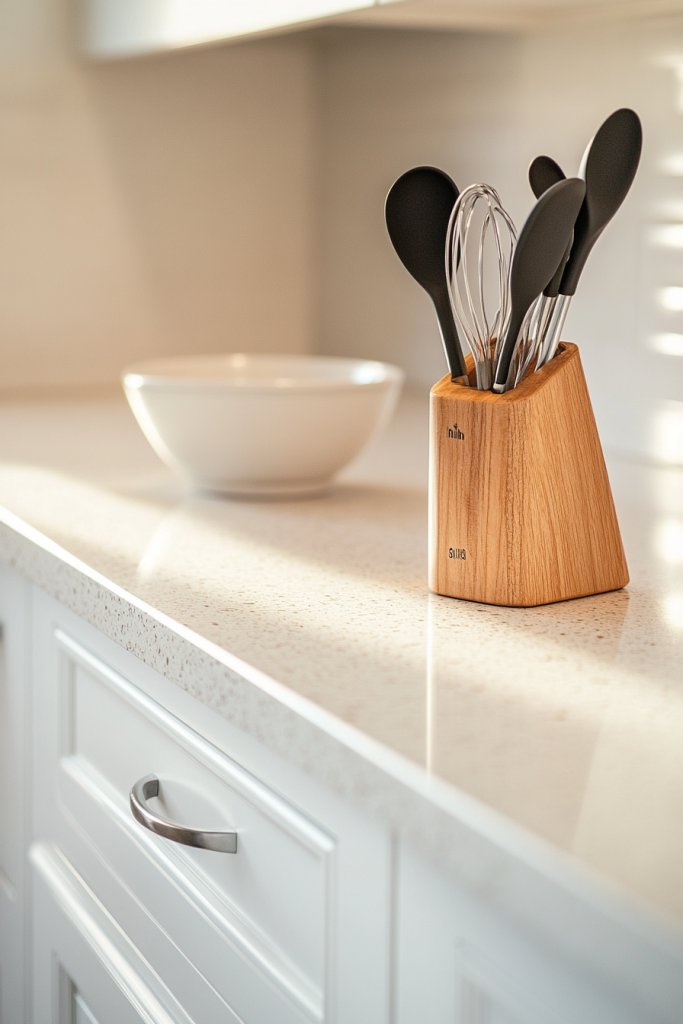
Surfaces like countertops, desks, and tables often become dumping grounds, making spaces look cluttered and chaotic. Having dedicated storage spots ensures everything has a home, keeping surfaces clean and your mind at ease.
Recommended Products to replicate this idea
| # | Preview | Product | |
|---|---|---|---|
| 1 |

|
Sterilite 6-Pack Industrial Tote, Plastic Storage Container Bins with Lids, 27 Gallon - Heavy-Duty... | Check Latest Price |
| # | Preview | Product | |
|---|---|---|---|
| 1 |

|
Vtopmart 25 PCS Clear Plastic Drawer Organizers Set, 4-Size Versatile Bathroom and Vanity Drawer... | Check Latest Price |
It’s a simple habit that transforms daily routines. Who wants to spend minutes searching for keys or mail? Visualize a tidy entry table with a small tray for mail and keys, a drawer for pens and chargers, and a shelf for frequently used items.
Everything is within arm’s reach but organized behind closed drawers or hidden compartments. The result is a neat, functional space that looks intentional and stress-free.
No more cluttered chaos. Use small baskets, trays, or labeled containers for different categories—mail, keys, tech accessories.
Incorporate drawer organizers or wall-mounted hooks to keep small items contained. Adjust storage based on your routine: a charging station near your desk or a dedicated spot for sunglasses.
Regularly review to prevent buildup. Identify your most-used surfaces and declutter them first.
Assign specific spots for each item—mail in a designated tray, keys on a hook, chargers in a drawer. Use containers that match your decor for a seamless look.
Establish a habit of putting items back immediately after use. Periodically reassess and declutter.
Label containers or drawers for quick identification, especially for shared spaces. Incorporate decorative trays or boxes that complement your style.
Use colors or textures that blend with your decor to keep everything cohesive. Personal touches like small plants or artwork can make these storage spots feel inviting.
Having dedicated spots reduces clutter and mental stress, making your home more peaceful. It encourages mindful habits and simplifies cleaning.
Over time, your surfaces stay neat with minimal effort. Ready to create a clutter-free zone? Start assigning spots now!
15. Incorporate Soft Lighting to Enhance a Calm, Tidy Atmosphere
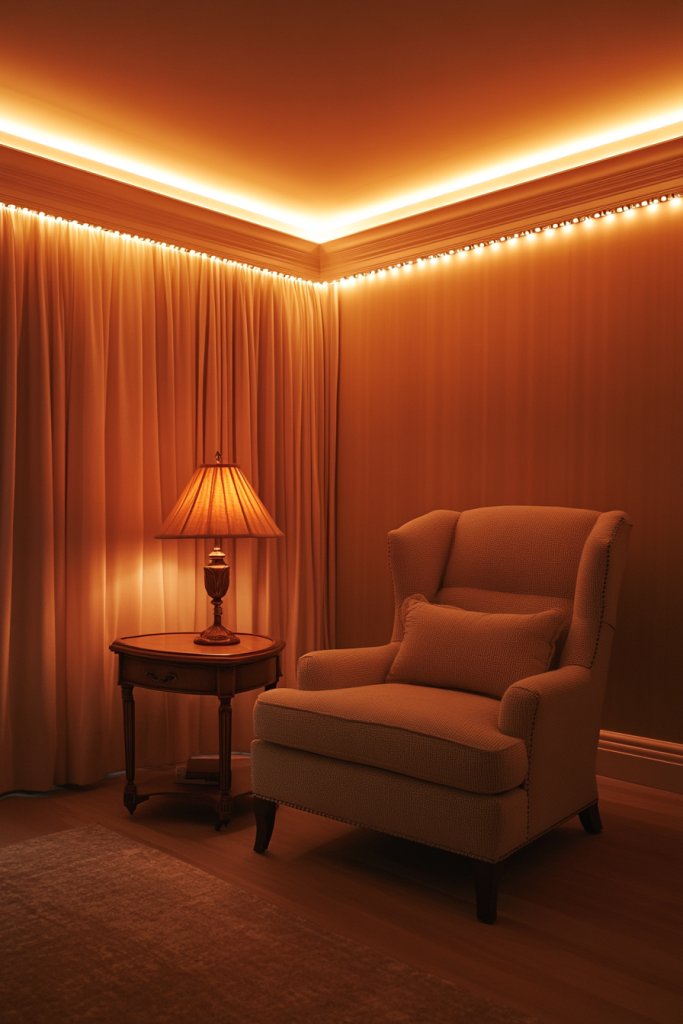
Harsh overhead lights can make a room feel sterile and uninviting, even if it’s tidy. Soft, warm lighting creates a calming ambiance that invites relaxation and makes your space feel cozy.
Recommended Products to replicate this idea
| # | Preview | Product | |
|---|---|---|---|
| 1 |

|
Wio-Mio Floor lamp, 15w/1000lm Bright LED Floor Lamp with Stepless Adjustable 3000K-6000K Colors and... | Check Latest Price |
| # | Preview | Product | |
|---|---|---|---|
| 1 |

|
DAYBETTER LED Strip Lights 130ft Lights Strip for Bedroom, Desk, Indoor Room Bedroom Brithday Gifts... | Check Latest Price |
It’s a simple change that can instantly elevate your home’s vibe. Who doesn’t want to unwind after a long day? Picture warm LED strips tucked behind crown molding or under floating shelves, casting a gentle glow.
Table lamps with soft fabric shades or wall sconces provide localized, warm pools of light. The overall effect is a layered lighting setup that feels warm and inviting, emphasizing cleanliness and simplicity.
It’s cozy without clutter. Use dimmable fixtures to control the mood, adjusting brightness for different activities.
Incorporate different light sources—like sconces, candle-like bulbs, or indirect lighting—to create depth. Match lighting finishes to your decor—matte black, brushed metals, or soft whites—for a cohesive look.
Experiment with placement for maximum effect. Start by assessing your lighting needs in each space.
Choose fixtures with warm, soft-white bulbs (around 2700K). Install dimmer switches for flexibility.
Use lamps or wall sconces in living areas and bedrooms, avoiding harsh ceiling lights when relaxing. Regularly clean fixtures and replace bulbs to maintain a fresh, inviting glow.
Add decorative lampshades or diffusers to soften light further. Incorporate string lights or fairy lights in decorative jars or woven fixtures for a whimsical touch.
Use lighting to highlight architectural features or textures, creating depth and warmth. Personalize your lighting to reflect your mood or season.
Soft lighting transforms your home into a sanctuary, promoting calm and well-being. It’s an easy upgrade that makes your space more inviting and stylish.
Over time, the right lighting setup becomes second nature—just flip a switch and relax. Want a cozy, tidy home? Start with soft lighting today!
16. Limit Decorative Accessories to a Few Meaningful Pieces
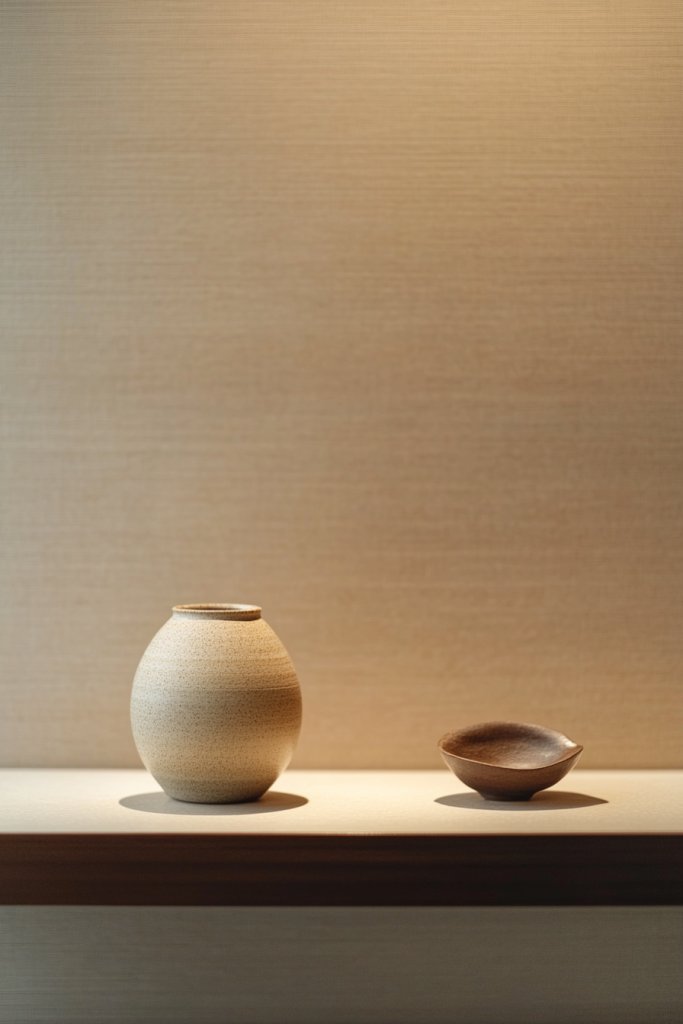
Cluttered surfaces filled with countless decorative items can overwhelm a space rather than enhance it. The minimalist approach champions fewer, more meaningful pieces to create a sophisticated, calm environment.
Recommended Products to replicate this idea
| # | Preview | Product | |
|---|---|---|---|
| 1 |

|
Ozzptuu Sandstone Resin Thinker Style Abstract Sculpture Statue Collectible Figurines Home Office... | Check Latest Price |
| # | Preview | Product | |
|---|---|---|---|
| 1 |

|
Vanselia Ceramic Flower Vase Home Decor - Farmhouse Table Vases Rustic Vintage Living Room Kitchen... | Check Latest Price |
Less clutter means more focus on what truly matters. Who doesn’t want a home that feels intentional? Visualize a coffee table with one sculptural object or a shelf with a curated collection of a few favorite items.
Each piece stands out because there aren’t dozens competing for attention. The overall look is balanced and peaceful, highlighting quality over quantity.
It invites admiration rather than chaos. Choose a small, curated collection of decor—like a few ceramics, a piece of art, or a plant substitute like a sculptural object.
Rotate items seasonally or for special occasions, keeping the overall number small. Focus on high-quality, timeless pieces that won’t go out of style.
Maintain a consistent style or color scheme for harmony. Start by decluttering your surfaces and selecting a few favorite items that reflect your personality.
Limit yourself to a specific number—like three or five—per surface. Use trays or stands to group items and create visual zones.
Regularly review your collection, removing anything that no longer serves a purpose or aesthetic. Keep it simple and intentional.
Pick decor that resonates personally—handmade crafts, heirlooms, or items with sentimental value—while keeping the number small. Use uniform materials or colors to create cohesion.
Display items thoughtfully, balancing negative space with visual interest. This approach makes each piece more impactful.
Limited decor highlights your taste and prevents visual overload. It makes your home feel elegant and thoughtfully curated.
Over time, you’ll learn which pieces truly elevate your space. Want a refined, peaceful home? Keep your accessories minimal and meaningful.
17. Use Clear Storage Containers for Easy Organization

Trying to find that one specific item in a cluttered drawer or cabinet is frustrating. Clear storage containers make it easy to see everything at a glance, saving time and reducing stress.
Recommended Products to replicate this idea
| # | Preview | Product | |
|---|---|---|---|
| 1 |

|
Vtopmart 6 Pack Clear Stackable Storage Bins with Lids, Large Plastic Containers with Handle for... | Check Latest Price |
| # | Preview | Product | |
|---|---|---|---|
| 1 |
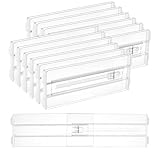
|
Vtopmart 12 Pack Drawer Dividers for Clothes, 4" High 10.2"-16.5" Adjustable Expandable Dresser... | Check Latest Price |
They keep your belongings organized and accessible, which is a game-changer for maintaining a tidy home. Who doesn’t want effortless organization? Picture uniform jars filled with dry goods in the kitchen or transparent bins holding craft supplies in the studio.
The contents are visible instantly, and everything looks neat because containers are consistent in size and shape. Labels add an extra layer of clarity, making tidying up quick and easy.
It’s organization that looks good and works well. Choose containers in materials that suit your needs—glass for food, plastic for toys, or acrylic for display.
Use matching or color-coded containers for different categories. Incorporate lids or stacking options to maximize space.
Seasonal or occasional items can be stored in larger bins, while everyday essentials stay within reach. Empty and clean your storage spaces, then categorize your items.
Transfer everything into clear containers, sealing and labeling as you go. Stack or arrange containers by size or frequency of use.
Regularly declutter and reorganize to prevent accumulation. Use drawer dividers or shelf organizers to keep everything tidy and visible.
Personalize containers with labels, decorative stickers, or color schemes that match your decor. Choose stylish containers that enhance your space’s aesthetic, like matte black or polished glass.
Incorporate small trays or risers inside larger containers to organize smaller items. Personal touches make neat storage more inviting.
Clear containers streamline your home, making everything easy to find and put away. They encourage ongoing organization habits and reduce clutter visually.
Over time, you’ll appreciate how simple it is to keep your home tidy. Want effortless order? Start with clear storage today!
18. Keep Floors Clear with Wall-Mounted Cleaning Tools

Cleaning supplies often clutter up closets or end up strewn across the floor, making your space look untidy. Wall-mounted storage keeps your cleaning tools organized, accessible, and out of the way.
It’s a simple way to keep floors clear and maintain a neat environment. Who wants to trip over a broom every time? Imagine a dedicated wall with hooks holding brooms, mops, and dustpans in a tidy, vertical arrangement.
The tools are within reach but don’t clutter your space. The wall looks clean and organized, making cleaning less of a chore and more of a quick task.
The visual cue encourages tidiness in your cleaning routine. Use sturdy hooks or racks in metal or durable plastic, depending on your decor.
For small spaces, install slim, vertical holders or pegboards. Label sections for different tools or cleaning solutions for easy identification.
Store rarely used items higher or in cabinets, leaving the essentials on the wall. Assess your cleaning tools and measure available wall space.
Install appropriate hooks with anchors for stability. Keep the arrangement functional—group similar tools and leave room for expansion.
Regularly wipe down the tools and check for damage or wear. Reorganize as needed to keep the system efficient.
Match hook finishes with your decor—matte black, chrome, or painted wood. Add small labels or icons for quick identification.
Incorporate decorative elements like a small chalkboard for notes or a stylish container for cleaning wipes. Personal touches make utility areas feel intentional.
Wall-mounted tools streamline cleaning routines and keep your floors clear, making your home safer and more inviting. Over time, this habit keeps your space consistently tidy and well-organized. Ready to hang and declutter? Let’s get those tools up on the wall!
19. Regularly Refresh and Reassess Your Space for Consistency
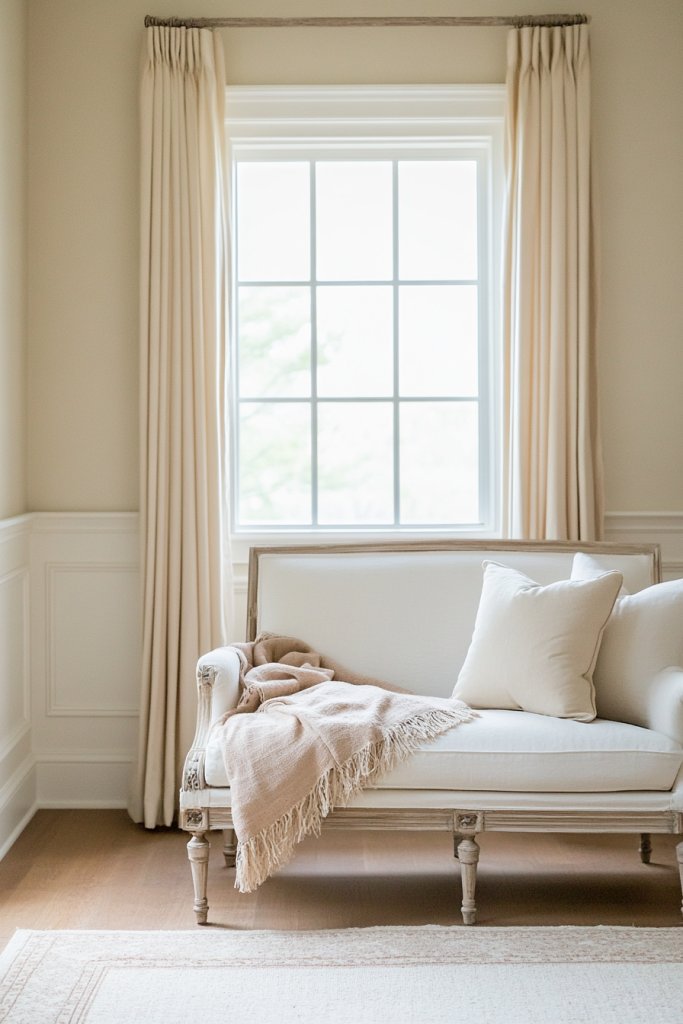
A home that’s perfectly tidy today can quickly become cluttered tomorrow without regular care. Refreshing and reassessing your space ensures it stays aligned with your minimalist goals.
Recommended Products to replicate this idea
| # | Preview | Product | |
|---|---|---|---|
| 1 |

|
Sterilite 6-Pack Industrial Tote, Plastic Storage Container Bins with Lids, 27 Gallon - Heavy-Duty... | Check Latest Price |
| # | Preview | Product | |
|---|---|---|---|
| 1 |

|
Mr. Pen- Double Headed Picture Hanging Nails, 50 Pack, Black, Push Pins for Wall | Check Latest Price |
It’s a proactive way to prevent chaos and keep your environment peaceful. Who wants to constantly fight mess? Picture a quarterly ritual where you go through each room, declutter, and reorganize.
Items that no longer serve a purpose are donated or recycled. Your space transforms from cluttered to calm, revealing the intentional design behind your choices.
It’s a cycle of renewal that keeps your home fresh. Set a routine—monthly or seasonal—to review your belongings and update decor.
Rotate decorative objects, change textiles, or refresh paint accents. This keeps your space feeling lively and aligned with your current taste.
Adjust storage solutions as needed to accommodate changing needs. Schedule regular decluttering sessions and stick to them.
Use checklists to evaluate each area, focusing on necessity and aesthetics. Replace or update items that look worn or no longer fit your style.
Keep a donation box handy for quick clearing. Maintain a habit of minimalism by questioning each new item before bringing it in.
Involve family members or housemates to keep everyone on board. Celebrate your progress with small rewards or new organizing tools.
Document your updates with photos to track your journey. Personal touches like new artwork or textiles can refresh a room without adding clutter.
Regular refreshes reinforce your minimalist lifestyle and prevent stagnation. They help you develop an intuitive eye for clutter and quality.
Over time, your home becomes a sanctuary that adapts to your life, not the other way around. Ready to keep your space consistently serene? Make reassessment a routine!
Conclusion
By exploring these minimalist secrets, you now have a toolkit of ideas to declutter and organize your home with style and ease. Incorporate these tips into your daily routine and watch your space become more peaceful and functional. Take action today—your simpler, tidier home is just a few thoughtful steps away!
Last update on 2025-12-19 / Affiliate links / Images from Amazon Product Advertising API